While most coins and bills you come across are only worth their face value, there are exceptions that can fetch thousands of dollars from collectors. One intriguing example is certain $2 bills, which, due to unique characteristics, might be valued at up to $20,000. Let’s explore how you can identify if you own one of these valuable treasures.
According to MarketWatch, some uncirculated $2 bills can reach values as high as $20,000. The key factors influencing their worth include:
- Serial Numbers
- The year the bills were printed
- Their overall condition
The serial number, found on both the left and right sides of the front of a bill, often accompanied by a letter at the beginning, is a crucial element that can significantly increase a bill’s value.
The Influence of Antiquity
Dustin Johnston, vice president of Heritage Auctions, shared with MarketWatch, “A serial number ‘1’ on a 1976 $2 bill could be worth $20,000 or more.” When it comes to collecting rare and valuable currency, certain serial numbers can make a bill exceptionally desirable. Among these are the intriguing “ladder” and “solid” numbers. A solid serial number is characterized by its uniformity, featuring the same digit repeated, such as 88888888888. In contrast, a ladder number impresses with its sequential order, displaying digits in an ascending pattern like 12345678910.
Johnston, a notable expert in the field, explained to a financial portal that a significant portion of a bill’s worth lies in its antiquity. Currency printed before the 1920s, now over a century old, frequently holds a value far exceeding its original face worth.
Factors Affecting Rarity
However, the year a bill was printed is only part of the equation. The rarity of a banknote is also influenced by other factors, including:
- The total number of banknotes printed in a specific year
- The remaining number of banknotes still in circulation
These elements combined can significantly affect the rarity and, consequently, the value of the currency. Collectors and enthusiasts continuously seek out these unique features, making them a fascinating aspect of currency valuation and collection.
When it comes to evaluating the worth of a bill, one crucial aspect to consider is its condition. Presenting a wrinkled bill to a collector is vastly different from offering one that has been meticulously maintained, or even categorized as a collector’s item and securely encapsulated for protection.
Key Factors in Determining the Value of a Bill or Coin
According to insights from the US First Exchange site, there are four distinct types of value that play a role in this assessment:
- Catalog Value
- Purchase Price
- Public or Retail Value
- Wholesale Value
Understanding Each Type of Value
The catalog value represents the average price at which most individuals would sell a coin or note. The purchase price is the amount a dealer might be willing to pay. On the other hand, the retail value is the price a specific dealer would sell a coin or note to you. Lastly, the wholesale value is the price used amongst dealers when trading with each other.
The portal emphasizes that determining the value of a coin or banknote hinges primarily on three main considerations: rarity, the condition or grade of the item, and prevailing market conditions, specifically the level of demand. The interplay of these factors ultimately dictates whether a coin or banknote is valued at a higher or lower price.
